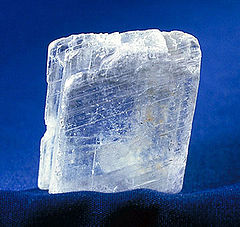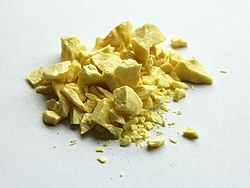Introduction
Hi readers! This time I wanna talk about mineralogy, uhm, a bit. In geophysics studies, minerals is a speaking stone. It tells us how was a layer of stone formed, what it should countain, and how old is it. A mineral is not eternal; the example being olivine. Olivine is a mineral that formed deep in the basaltic magma chamber. This green, transparent and beautiful mineral is hard. Beside its hardness, when it is put in the river, it would oxidize into another mineral called iddingsite, with different chemical composition than olivine. Another example being graphite that is compressed and heated near earth mantle, after which it changes into diamond. What making minerals ephemeral is simply the geologic processes - it changes the position of minerals in the Earth. For minerals, changing of position also means changing of thermodynamic condition and physical treatment. An igneous stone blasted by volcano, sooner or later would be carried into sea. In the sea, rock powder soon turned into layers of sediment rocks because of pressure brought by water weight. Then the plate tectonic mechanism drive the sediment to the trench and here the sediments are pressed as much as several gigapascals into metamorphic rocks. If lucky, some of the metamorphic rock is lifted again to the earth surface, creating mounts of marbles. If not, it melt again in the astenosphere, becoming magma and repeat the cycle.
How Does Minerals Form ?
Minerals are natural things, so diamonds produced at factory, instead of having near-original diamond qualities, is not called mineral. Because mineral is natural, so its forming process is always natural (not man-made). And also, differ crystal and mineral. We can grow mineral's crystal in laboratory, but we can not call that crystal as 'mineral'. Also, a volcanic lava which cools fast can not make their mineral into crystals - that's why we see igneous rock as black or gray. A black volcanic stone consist mostly of hornblende mineral while the grey one may have more mica or orthoclase mineral content.
Minerals are formed by following ways:
So the conclusion is, mineral formation is ruled by the change of temperature or pressure surrounding the mineral. In the case of gas deposition and evaporation, the pressure contributing there is atmospheric pressure.
All mineral is starting as a small 3D molecule called nuclei. When surrounding temperature and pressure is suitable for the nuclei, the nuclei started to attract other atom possible for binding with it. The amount of possible atom + speed of temperature change + room provided in the system (remember, there are so many similar nuclei sharing limited place together) determine the shape of mineral. If the room is large, temperature change is slow and possible atom is many, a mineral can grow into a huge, perfectly shaped one.
Minerals are formed by following ways:
- Evaporation from solution.
- Gas deposition.
- Crystalization.
- Growing in solid substance.
- Chemical reaction between two different phases.
- Evaporation from Solution When seawater is flowing into shallow evaporation ponds at morning, it will be heated by sun to a temperature possible for water molecule to break off connection with Na+ and Cl- and fly away to the air. After Na+ and Cl- ion break up with water, they will connect each other again to make NaCl (Halite mineral, common salt). If sea level recedes, more halite is deposited on land, creating salt pan. Sediments may bury the salt pan and geologic process fold that salt layer, because of its elasticity the salt layer may turn into a salt dome and mined by man as rock salt. Another example is calcite in caves, travertine stairs, or blotch of iron rust lining your tap in garden (that iron rust might not coming from your oxidizing tap but from acidic ground water that contain so much Fe2+ ion).
- Gas deposition While volcanic gases out from an erupting volcano, some of its content directly deposit into crystal. The simplest exapmle is sulphur. The deposition of sulphur is reasonable after seeing its phase diagram. Another kind of gas deposition may be occured deep in magma chamber, when bubbles of gas deep from astenosphere enter it and stick with magma chamber's outer stone roof. When sticking with the magma chamber's roof, some mineral in the gas deposited there.
- Crystalization In mineralogy, the term crystallization refers to magma or lava crystalizing when it reaches a spesific crystallization temperature. The magma, liquid form of igneous rock in the depth of earth's crust, crystalization process is so slow that the mineral there can grow into amazing sizes. Why so slow? What makes it slow is because the temperature of magma decreases slowly. The effect is it can maintain a spesific crystalization temperature for a very long time, say it could be hundreds of years. Lava is magma that reaches the earth's surface. Some lava cool fast and some slow, the faster it get cools, the smaller is the crystal size. Obsidian, a stone resulted from fastest cooling lava, has no crystal structure yet it have a vitreous (glassy) look. Andesite, another igneous rock, cools slower; the temperature of its parent lava may be as high as 700o C 2 weeks after the eruption ceased. The effect is andesite's mineral can be barely seen by naked eye. The slowest cooling magma, deep beneath earth surface, producing pegmatite. Minerals composing pegmatite is so big that we can analyze them one by one.
- Growing in solid substance This process is known to metamorphic stones. When a sedimentary or igneous stone is buried deep in earth's crust by means of geologic processes, it would face tremendous amount of heat and torturing gigapascal pressure. This coupled torment mechanism drive the molecules of rock mad. That mad molecules soon adapt to that condition (they surely can go nowhere :-D ) by reconstructing their chemical bond. When they reconstructing, it is the time when a new crystal is grow within the old one.
- Chemical reaction between two different phases When a solid mineral is exposed to some gases or liquid, some or all atom composing that mineral would be exchanged to that gas/liquid. This kind of chemical reaction surely resulted in new mineral with different chemical composition. For example, see the aforementioned olivine case. The hotter the reaction place, the faster it get done -> the concepts of activation energy of reaction.
So the conclusion is, mineral formation is ruled by the change of temperature or pressure surrounding the mineral. In the case of gas deposition and evaporation, the pressure contributing there is atmospheric pressure.
All mineral is starting as a small 3D molecule called nuclei. When surrounding temperature and pressure is suitable for the nuclei, the nuclei started to attract other atom possible for binding with it. The amount of possible atom + speed of temperature change + room provided in the system (remember, there are so many similar nuclei sharing limited place together) determine the shape of mineral. If the room is large, temperature change is slow and possible atom is many, a mineral can grow into a huge, perfectly shaped one.
Types of Mineral
In the earth, there are more than 4000 mineral. Broadly speaking, the 4000 mineral is divided into two main groups, the silicate and non silicate type. Further, the silicate type is divided into six group based on its molecular structure:
The other non silicate mineral is divided into 8 groups:
- Nesosilicates Silicate minerals composed of separated, alone SiO4 molecule.
- Sorosilicates Silicate minerals composed of paired two molecules of Si2O7 connected at one oxygen atom.
- Inosilicates Divided again into single chain inosilicates and double chain inosilicates. Single chain inosilicates are silicate minerals composed of lines of SinO3n connected at two oxygen atom. The double chain one is simply two opposing single chain connected together.
- Phyllosilicates Chains of inosilicates connected to its neighbors, creating a vast layer of silicate molecules. Each layer is connected to another layer via metallic ions between them.
- Cyclosilicates In this type of mineral, silicate molecule making a closed structure like triangle, square, or hexagonal. Ratio of Silicon versus Oxygen is 1:3.
- Tectosilicates Tectosilicate mineral has wireframe molecular structure; I mean that every silicate molecule bond tight with the other silicate molecule without specific structure, so that tectosilicate can resist weathering and other chemical reaction better.
The other non silicate mineral is divided into 8 groups:








No comments:
Post a Comment